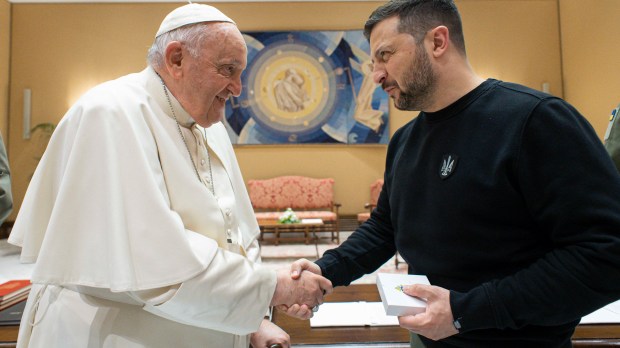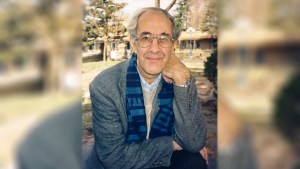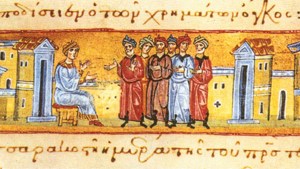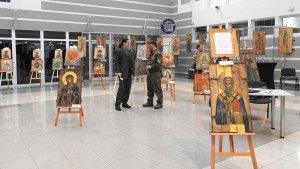As rumored, the president of Ukraine arrived at the Vatican this May 13 around 4:10 pm. His motorcade did not take the Via della Conciliazione as is usually the case for presidential visits, but arrived in St. Peter’s Square via a side road. The Regent of the Prefecture of the Papal Household, Archbishop Leonardo Sapienza, greeted him as he got out of the car and led him into the aula of the Paul VI Hall.
Wearing a simple sweater and military pants, as has been his custom since the beginning of the war, President Volodymyr Zelensky was greeted by the standing Pope, who walked with the aid of a cane to accompany him to the office.
The Pope thanked him for his visit, and the Ukrainian president said he was “very honored,” bowing and placing his hand on his heart. Their meeting lasted about 40 minutes. The president then met for about 30 minutes with Archbishop Paul Richard Gallagher, Secretary for Relations with States, in the presence, among others, of Andrii Yurash, the Ukrainian ambassador to the Holy See.
Cardinal Pietro Parolin, the Pope’s Secretary of State, was absent due to his visit to Portugal.
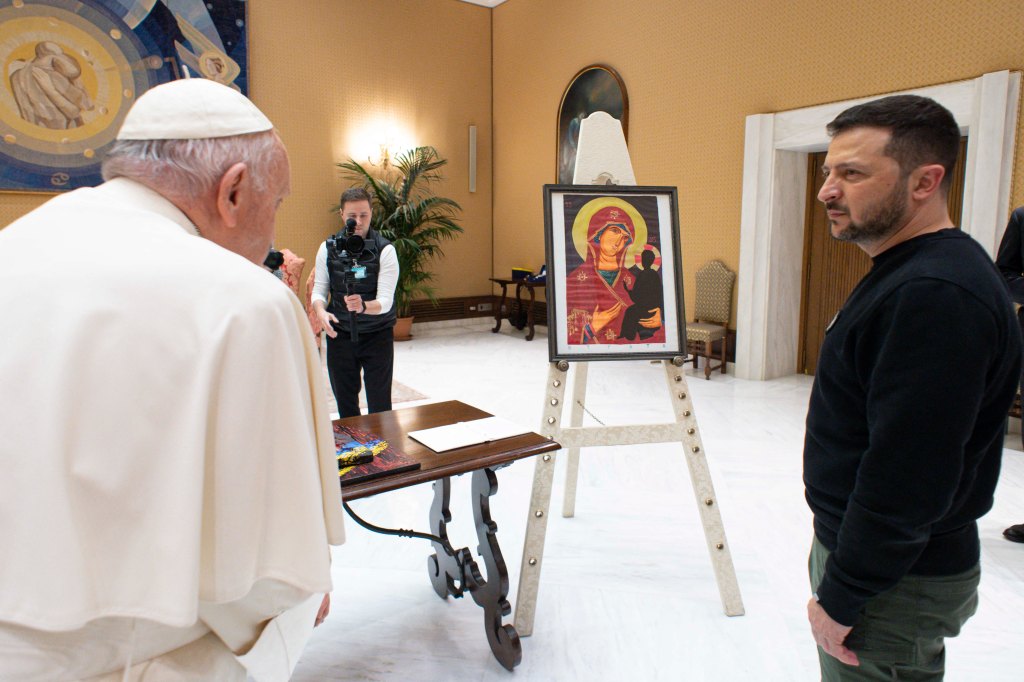
In a statement issued moments after the president’s departure, the director of the Holy See Press Office, Matteo Bruni, said that the meeting between President Zelensky and Pope Francis focused on “the humanitarian and political situation in Ukraine caused by the ongoing war.”
The Pope assured the Ukrainian president of his “constant prayer,” which he himself has witnessed through the Pope’s “numerous public appeals and continuous invocation to the Lord for peace, since February of last year,” he added.
The two leaders agreed on the “need to continue humanitarian efforts in support of the population,” said Bruni, adding that the Pope stressed in particular “the urgent need for gestures of humanity towards the most fragile people, innocent victims of the conflict.”
The Ukrainian president presented the Pope with a work of art made from a bullet-proof vest, and a painting entitled “Loss,” depicting the massacre of children during the conflict.
Pope Francis offered him the book An Encyclical on Peace in Ukraine, as well as a bronze work representing an olive branch, a symbol of peace. He also gave him, as he does to all leaders visiting the Vatican, the texts of the Message for Peace of January 1, 2023, the Document on Human Fraternity signed in Abu Dhabi in 2019, and the book on the Statio Orbis of March 27, 2020.
The war was naturally also at the center of the exchange between the Ukrainian president and Bishop Gallagher. The press release from the Secretariat of State specifies that the dialogue focused on humanitarian emergencies and “on the need to continue efforts to achieve peace.”
“The occasion was also propitious to deal with certain bilateral issues, relating above all to the life of the Catholic Church in the country,” the statement said.
Ukrainian president does not want mediation
In a statement broadcast on his Telegram channel, President Zelensky explained that his meeting with Pope Francis focused on “ending Russian military aggression” and “restoring peace.” He asked for the support of the Pope for “the implementation of the Ukrainian formula for peace, in particular with regard to food security, the release of prisoners and deportees and the restoration of justice. Since the war is on the territory of Ukraine, the peace plan can only be Ukrainian,” he insisted.
He also discussed with the Pope “the question of Russia’s crimes relating to the kidnapping and deportation of Ukrainian children.”
He asked the Vatican “to join Ukraine’s efforts to return Ukrainian children brought illegally and forcibly to Russia, abducted in fact,” he explained.
Invited in the evening of the program Porta a Porta , broadcast on the RAI1 channel, the Ukrainian president expressed a relatively distant position vis-à-vis the positioning of Pope Francis.
“For me, it was an honor to meet His Holiness, but he knows my position: The war is in Ukraine, the plan must be in Ukraine, for the Ukrainians,” explained the president. “We do not need a mediator between Ukraine and the aggressor country,” because Russia “will block everything,” he stressed, pointing to the failure of the Minsk agreements and meetings in the ‘Normandy format,’ which from 2014 to 2022 had given Russia time to consolidate its positions.
He nevertheless “felt the support of the Vatican, Italy and many countries of the world,” for the search for peace in Ukraine, he explained.
1st direct meeting since the beginning of the Russian offensive
This was the second meeting of Volodymyr Zelensky with Pope Francis, after a first visit on February 8, 2020, a few months after his election as head of Ukraine. At that time, the young president explained that he had asked the Pope “to help free Ukrainians imprisoned in the Donbass, Crimea and Russia.” However, this was his first visit to the Vatican since the start of the large-scale Russian offensive on his country that began February 24, 2022. The two leaders have, however, spoken by phone at least three times in 2022.
Moments before the president’s arrival at the Vatican, some families had gathered near St. Peter’s Square, carrying flags of Ukraine. “We need the Pope to understand our situation. We know that he wants to bridge the gap between the two sides. But we will make peace when the Russian troops have left Ukrainian territory,” Natalia, a Ukrainian mother waving a blue and yellow flag, told I.MEDIA.
The president and the international scene
For security reasons, President Zelensky chose not to travel abroad when the Russian attack began. Taking off from Polish territory, reached from Kiev by train, he nevertheless resumed his international travels at the end of 2022, visiting Washington on December 21, London, Paris and Brussels in February 2023, Warsaw on April 5, and Finland and the Netherlands on May 12 and 13.
His trip to Rome is part of his desire to build military alliances and obtain international support for the reconstruction of Ukraine. Italian Prime Minister Giorgia Meloni, who received him warmly in the early afternoon, has always affirmed her support for Ukraine, although two parties in her right-wing coalition, the Lega and Silvio Berlusconi’s Forza Italia, have traditionally held positions close to Russia’s.
The Ukrainian president met in the middle of the day with the President of the Italian Republic, Sergio Mattarella, who reaffirmed his country’s support for Ukraine “in terms of military, financial, and humanitarian aid” as well as for reconstruction, “in the short and long term.”
“Not only the independence and territorial integrity of Ukraine, but also the freedom of peoples and international order are at stake,” insisted President Mattarella.
“I would like to embrace the Italians one by one for the support that has been continuously offered to us at all levels, and that has not changed with the governments (Draghi and Meloni),” said Zelensky during his visit to President Mattarella.
More than 120 appeals
Pope Francis has spoken more than 120 times on the war in Ukraine. He has continued to call for an end to the fighting, though sometimes causing chagrin among Ukrainians and their allies, who have considered that he has spoken too favorably of Russia.
On April 30, on his return flight from Hungary, three days after receiving Ukrainian Prime Minister Denys Smyhal at the Vatican, Pope Francis expressed the availability of the Holy See for mediation on behalf of Ukrainian children who have been kidnapped and transferred to Russia.
According to the Italian press, Pope Francis has given to the Russian ambassador Alexander Avdeyev, received for a departure visit on May 11, a letter on this issue to Vladimir Putin.
Pope Francis, who has met three times with the Russian president at the Vatican in 2013, 2015 and 2019, has not managed to establish direct contact with the Kremlin leader since the beginning of the Russian offensive in Ukraine.
